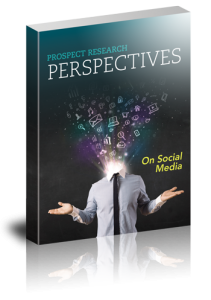 Partner with a prospect research professional! As a fundraiser, why should you partner with a prospect research professional to find new prospects? Couldn’t you use a research software product or buy a prospect list?
Partner with a prospect research professional! As a fundraiser, why should you partner with a prospect research professional to find new prospects? Couldn’t you use a research software product or buy a prospect list?
Whether you look inside or outside of your database, you can easily generate a prospect list at the click of your mouse. Silicon Valley is certain that data technology solutions can fix whatever ails us – and in theory, why not? But in practice our data is every bit as fallible as we humans who create it.
Prospecting for donors follows this same pattern. Sure you can get a list of prospects from software, but you will be stumbling over errors in no time. Things like a donor who made a memorial gift when her dad died, but is unlikely to give at that level again. Or a common last name erroneously matched to wealth.
And then there are the prospects that are omitted. Where is the woman who volunteers in your program and lives in that multi-million dollar home? Or what about the young couple that make a small annual gift, but you know they have inherited wealth?
It doesn’t mean that the wealth screening or prospect list is useless. It means you need someone who understands the data and fundraising to partner with you to refine the list. You need a well-trained prospect research professional.
Following are five ways that partnering with a prospect research professional can get your major gifts program galloping:
- Verify the data: A wealth screening zips through thousands of records. When a researcher performs a double-check on your highest-rated prospects, you don’t waste time with duds.
- Track progress: Without a way to track your major gifts progress, your chances of achieving your goals drops dramatically. Prospect research professionals excel at tracking and reporting.
- Deliver custom information: Every organization is different and each fundraiser is different. Partnering with a prospect research professional creates a give and take resulting in information delivered how and when you need it most.
- Creative sourcing: The prospects you need might not surface with the usual screening products. Well-trained prospect research professionals creatively source the right prospects inside and outside the database.
- Translate and adapt: As the fundraiser, how well do you need or want to know the details of data technology? A well-trained prospect research professional translates the software, adapts, and delivers it to you in a form you can use.
When you are ready to dedicate time and attention to cultivating, soliciting, and stewarding major gifts, enlisting the services of a well-trained prospect research professional will produce the forward momentum you need to achieve major gift success.
More Resources You Might Like
- Warning! Anyone can do analytics. (A story about finding major gift “unicorns”)
 Public companies create an enormous amount of wealth in the United States. Having the designation as a public company insider is a neon-lit indicator for high net worth!
Public companies create an enormous amount of wealth in the United States. Having the designation as a public company insider is a neon-lit indicator for high net worth!
 Gift capacity ratings were a marketing moment for wealth screening companies. Suddenly thousands of records could be matched individually to wealth records and assigned a score. Your constituents could be assessed by their potential capacity – in the form of dollars. And everybody loves money. Have gift capacity ratings lived up to the hype? Yes!
Gift capacity ratings were a marketing moment for wealth screening companies. Suddenly thousands of records could be matched individually to wealth records and assigned a score. Your constituents could be assessed by their potential capacity – in the form of dollars. And everybody loves money. Have gift capacity ratings lived up to the hype? Yes! There was a cry for help on the PRSPCT-L list-serv: “I’m a new researcher and my boss wants me to provide net worth on a prospect. He says it was the previous practice to do this and I can get what I need to calculate it from Dun & Bradstreet.” What would your response be?
There was a cry for help on the PRSPCT-L list-serv: “I’m a new researcher and my boss wants me to provide net worth on a prospect. He says it was the previous practice to do this and I can get what I need to calculate it from Dun & Bradstreet.” What would your response be?
 How many times have you lamented: “Yet another prospect involved in the family business. The family’s privately-held business, that is. What valuation number am I going to pick out the air this time?!” We’ve all been there. Valuing private companies is a tricky business indeed (pun intended).
How many times have you lamented: “Yet another prospect involved in the family business. The family’s privately-held business, that is. What valuation number am I going to pick out the air this time?!” We’ve all been there. Valuing private companies is a tricky business indeed (pun intended).


 Women may be just under half of the world’s population, but they represent 11% of the 2015
Women may be just under half of the world’s population, but they represent 11% of the 2015  Looking back on 2014 I realize that I’ve done quite a few screenings and research verification projects. And that means I’ve had lots of conversations with fundraisers who ask a lot of the same questions. I thought you might like to eavesdrop on some of those Q&A’s!
Looking back on 2014 I realize that I’ve done quite a few screenings and research verification projects. And that means I’ve had lots of conversations with fundraisers who ask a lot of the same questions. I thought you might like to eavesdrop on some of those Q&A’s!